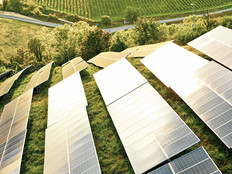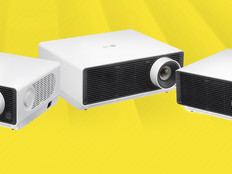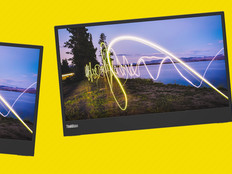Blades Give DFW Airport a Lift
ClearCube blades power flight information displays to cut costs and speed maintenance.
How many airport workers does it take to reboot a PC? Three, if you count the person driving the forklift.
Forklift? That’s right. Until 2006, IT workers at Dallas/Fort Worth International Airport had to hoist themselves 15 feet in the air to access the more than 1,000 PCs that powered the flight information displays that let travelers know their flight’s on-time status. Each 42-inch liquid crystal display had a PC bolted to the back of it.
The deployment at the world’s third-busiest airport was expensive, hazardous, awkward and — says William Flowers, DFW vice president of IT — absolutely the best option available at the time. But things needed to change. “We knew there had to be a better way,” says Flowers. “When we started to design Terminal D, we looked at how we could more easily deploy IT.”
The better way was to deploy ClearCube blade PCs. Dallas/Fort Worth began the rollout in 2005 in its brand-new, 2 million-square-foot International Terminal D — a bustling hub capable of handling as many as 37,000 passengers and 30,000 pieces of luggage per day at full capacity — and its car-rental facility. Within a year, DFW had rolled out the ClearCube blades to all five of its terminals.
The blade PCs are placed in 48 small data rooms throughout the airport, including 40 in Terminal D. From there they are connected via standard Ethernet cables and small user port devices (each about the size of a paperback book) to the display screens. The airport also uses ClearCube user port accessories, called Multi-Video eXpanders (MVX), located between the displays and the user ports, which allow one blade to drive up to four displays.
DFW is one of the first airports to embrace blade technology on such a vast scale. But in doing so, it follows a clear trend among other large organizations. In fact, while most IT sales have been unable to escape current economic hardships, blades continued to show positive sales growth from the third quarter of 2007 to the third quarter of 2008, according to Jed Scaramella, senior research analyst in International Data Corp.’s Enterprise Computing group. “IT customers continue to adopt blades due to energy efficiency, serviceability and flexibility benefits derived from the consolidated platform,” says Scaramella.
Airport Infrastructure
On the back end, blades powering the flight information displays are connected to redundant data centers in International Terminal D. There, other blades run DFW’s airline operations software, including a baggage information application, gate information, reservation terminals and e-ticket kiosks. “Blades have worked so well that we took the whole concept of a blade environment and built it into the whole terminal,” says Flowers. In both centers, blades run operating system and database software. Beneath them runs a virtual storage area network, which allows data to stay in sync and be presented to applications with a single view.
The ClearCube blades offer several improvements over individual PCs. First, because the blades are centralized, maintenance is quicker and requires fewer people. In 2000, when the Love Bug virus was spreading, IT workers had to go up on lifts and update the antivirus software on each PC. Now, the airport’s IT staff in the main data center in Terminal D can execute all tasks either remotely through the ClearCube management software or directly within the telecom closet. Also, in the event of a hardware failure, the IT manager can switch to a new PC blade in seconds. For the 18,000-acre DFW Airport, the centralized setup means less walking for IT staff.
Second, the blades offer greater flexibility in deployment because they can be housed up to 600 feet away from the displays. Ethernet deployments usually are limited to 300 feet. Having them tucked away in closets makes the public area less cluttered — no forklifts in the way.
Third, the blades are more energy-efficient than standard PCs. That means they take less power to run and less power to cool. “When we look at the initial cost, we saved half of what we would have spent if we were to buy one PC for every display. The ClearCube blades and the MVXs allow us to run up to four displays for each blade, although we’ve opted to leave it at a 3-to-1 ratio,” says Flowers.
Finally, blades help DFW contain costs. That’s been particularly important since 2000, when the airport took over many of the technology services, including operation and maintenance of the flight information displays, from individual airlines.
“It’s easy: Blades are easier to maintain with fewer people,” says Flowers.
Environmental Initiatives
Dallas/Fort Worth International Airport’s decision to deploy blade PCs is part of a broader move by the airport to go green, says William Flowers, DFW vice president of IT. “We’re looking at every opportunity. Blades save heat and power,” he says.
DFW has been singled out by the U.S. Environmental Protection Agency for its green efforts. Recently, DFW joined the EPA’s National Environmental Performance Track program, a consortium of public and private organizations working with the EPA to reduce the use or release of 31 priority chemicals. In September 2007, as part of the National Partnership for Environmental Priorities, the airport pledged to reduce 940 pounds of pendimethalin and trifluralin found in herbicides used to treat airport grounds. DFW is one of only four airports nationwide to join the NPEP program.
Among its other green feats, DFW International says that between 2002 and 2007 it captured and treated 5 million pounds of spent aircraft deicing fluid, preventing its discharge to the creeks and rivers surrounding the airport, and reduced the airport’s ongoing energy demand by 25 million British thermal units.
DFW at a Glance
- Size: DFW covers more than 29.8 square miles
- Real property consists of 18,076 acres (7,318 hectares)
- Year opened: 1974
- World rankings: 3rd in operations 7th in passengers
- Daily passengers: Approximately 164,000
- 2007 total passengers: 59,786,476
- 2007 total international passengers: 5,550,429
- Total destinations: 173
- Number of airlines: Domestic: 13, Foreign flag: 7






